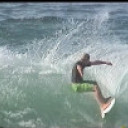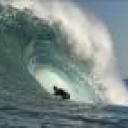South East Queensland and Northern New South Wales Surf Forecast (issued Monday 17th March)


Qld buoys are back online, and seem to have never really went anywhere


Ben, just wondering if you could explain more around why you think models have overcooked this upcoming long period groundswell (6ft+ versus your call of 3-5ft at most open beaches)?


Totally agree. swell decay always seems a bit more significant than models estimate for these date-line swells.


Thanks Ben.....but why 6ft+ at exposed spots but only 3-5ft at open beaches? The swell period is seriously up there so I can't see why you'd get too much decay from an outer bombie compared with an open beach?
Also, from the models I'm looking at, the forecast swell heights and period are almost identical to the Lusi forecast.
Don't get me wrong, I agree that for a fetch this far from the coast I'm staggered the models are currently indicating 5-6ft+, considering the initial wave heights in the storm fetch are less than what was modelled for TC Lusi. However Nick Carrol once said that swell decay from small, localised fetches like TC's is much worse (ie more decay) than from a long elongated fetch like we're seeing out near the dateline.


Spot on Ben, you nailed that swell again I reckon and you are so correct about various spots being bigger than other spots a few hundred meters away.
Seen the photos and you were right about the coast South will all be even size.
Wasn't big like Queenio Bombio, but Sunday late arvo was soild 6ft on the open beach we surfed :)


Hey, Mitch!!! Yesterday (in another thread), we were chatting about a certain reef...... You by chance didn't happen to see it super early last sunday morning did you? As in sunup? Also just north of there is a beachy known to handle larger swells thanks to offshore bommies splitting the swell and causing insane wedges at times.... Any news on that spot early sunday?


Hey SD. Nah checked it at 6. Bumpy & washing through. The adjacent reef was all over the shop too, but saw a couple psycho barrel sections amongst it. No news on that other spot either, everyone was rubbing shoulders with Tim B.


Hey Stu Nettle,
I was down on the coal coast on Sunday, was the reef you were at south or north of the Gong?


Cheers, Mitch... There's another spot I'd like to ask you about, but I can't think of a way to cryptically name it...... A very guarded reef, not "kongs island" either..... ummm shit... hmmm...????


I know Mitch... the most eastern point in Australia has one..... So does just north of the places we've been talking about....... Look due east and directly below that........ U know where? Any news on that spot?


Haha nah SD, the clowntown locs kept it pretty local, as you can imagine with the wind. I was talking to one guy from the maroochy area, but he didn't say anything remarkable about it, he was more than happy to trade quality for uncrowded waves. On sat morn, the 2nd spot was good, not all time, but some good banks and average banks. Some solid but not maxing size and pretty friggin crowded.


Yeah, I could imagine the crowd.... Insane...... I heard "that reef" was pumping early sunday..... But just after 7ish, the wind started to funnel around the point, and it went off the boil. Kongs left was smoking by all reports.... Totally Insane at dawn, still good as the wind picked up, but the last section got a bit backwashy from the northerly wind chop wrapping around, if you get my drift........ Take off and first two sections were still protected.... Cheers


Cheers SD. I was trying to convince a mate to come up for a proper surf, and meet another mate who was heading down to where your old sea dog song writing friend dreams of. But mate A was trying to combine gf time with surfing (bloody drongo!) and complained about not being fit enough after a snowboarding holiday.
Good on those guys for scoring early, there's always people watching that spot, walking dogs, etc. Not sure how many would've seen the beachie and seen the waves against the point and still wanted to surf it. Actually, I'm not even sure we're talking the EXACT same wave. To be honest I ruled out everywhere, bar the spot wit hteh photos, as the wind chimes were chimin' all night! So, I'll just have to be more selfish next time and just spend an hour pre-dawn checking everything myself


Mitch. - you write "I'm not even sure we're talking the EXACT same wave." Does this give you a clue?
Lefthander, too small this day, but you can see the reef....


ok we are. Never seen it work properly. you can probably take that post down now :|


Thanks though


Craig, cyclone heta comes to mind... Hasn't been that many cyclones "out here" in recent times thanks to La nina. They still occur out that way during la nina, but not as often...
But there is an x factor to this current setup........ A 4000 km trade fetch.....



4800km actually SD!!! ;)


NOOOOOOO!!!!!!!!! ;)
Hey, Don.... I'd like your opinion on swell "diluting".
Here's 3 very basic hypothetical scenarios;
1 - a 15 second groundswell has to travel 4000 km...... During that time, it travels into a 15 knot "offshore".
You'd have to say the swell will "dilute" quite a bit, right?
2 The same 15s swell travels 4000km, but over that area is a large high with minimal light variable winds.
The swell will dilute, but not as much as scenario 1. That would be a fair call, right?
3 The same 15s swell travels the 4000km, but with a 20 knot firm tradewind helping it over the whole distance.....
How much will the swell dilute compared to scenarios 1 and 2?


Now we're getting complicated.
Remember that swells carry their energy below the sea surface, decreasing exponentially with depth.
Also each swell has a different frequency and energy which pass through each other practically unaffected.
Ie a south groundswell will meet a north groundswell and both will pass through each other unaffected. They don't cancel each other out. What can happen locally at the beach though is that if two swells from opposite directions fall in sync, a doubling up wedge can result, or quite opposite a cancellation, but this is only in the near-shore zone and looking at single wave on another wave, not the overall swell.
So a stiff offshore blowing into an oncoming swell won't take much energy at all way from it, as it's mostly hidden under the surface. It may take some small amount of energy off due to white-capping etc, but only if strong enough.
Now, the theory about a wind blowing with the swell, unless this wind is the same strength or stronger than the winds that set the swell in motion it won't add anymore size to it. What it will do is added to the lower period energy in the water, relative to the wind strength, and provide more of those waves seen in between the bigger sets.


So, craig, when you look at the map above, I might be correct when I say this swell may not be as inconsistent as some may think..... It WILL be inconsistent, but better than alot of long distance swells for this region...
Below is an archive map. Note no real fetch like the one above..... It would be interesting to see the "Double island point to Coolangatta" report for 3/1/2002 to 7/1/2002, but BOM don't keep those archives on their site, and I couldn't be bothered emailing them...



No the main groundswell will be extremely inconsistent, even the moderate sized trade-swell.
When people read the forecasts they really just want to know how big, if the winds are good and also if there is some form of inconsistency with the swell.
And with this tropical setup being so far away, the inconsistency cannot be stressed enough.
It's even more dangerous for swimmers and rock fishers than surfers (who have some understanding on how long-range groundswells work).


Craig, this is probably a better map - different system, better position compared to current storm.



Craig wrote:unless this wind is the same strength or stronger than the winds that set the swell in motion it won't add anymore size to it.
If this was the case, would it amplify each wave in the same swell train? or will produce a duplicate the initial swell train, thereby creating bigger surf when the two trains double up? Assuming the decay is negligible, say for NZ EC in this case perhaps?


actually, rate of decay decreases with time doesn't it? so disregard the NZ EC example


Yeah, rate of decay decreases with time, ie the greatest decay is seen in the first few hundred kilometres that the swell travels away from its source.
Not quite sure on that other question sorry.


Craig, best map yet ( and final map)..... Yes, this storm was bigger, it's in a very similar position to the current storm, but the fetch above NZ is a little smaller... Historically, this cyclone pumped up to 8 feet solid on the Sunny coast...... check article below map.... ( This swell will be 4 to 6 foot)...

"Coast braces for Olaf" - http://www.sunshinecoastdaily.com.au/news/scd-coast-braces-for-olaf/324341/


Craig wrote:unless this wind is the same strength or stronger than the winds that set the swell in motion it won't add anymore size to it.
Let's say: this wind IS the same strength or stronger than the winds that set the swell in motion... then it WILL add more size to it. Correct?
And if so, in what manner?
a) amplify the wave heights of "the swell"?
b) i) a 'same or stronger swell' will be set in motion?
ii) sets from this 'same or stronger swell', will sometimes double up on sets from "the swell"?


And where I'm trying to go with this is...
if b) is true, then is the reverse situation also true?
c) i) "the swell" travels through fetch b), but in this case fetch b) is blowing in the opposite direction.
ii) "the swell" does not change its characteristics
iii) swell c) is developed as per usual


Mitch I think we need a flowchart, or a Venn diagram. You're all over the place with your subquestions.
The wind will act upon the current sea state, it can't create an exact copy as the surface it is acting on isn't the same.
Think of the swells as sand dunes on a beach, with bulldozers representing the wind. A certain amount of work by the bulldozers (fetch, strength, duration) will create a dune of a given height (amplitude) and slope (period).
Swell decay can be represented by a sprinkler set on top of the dune, the longer it is there the flatter the dune will end up. The higher the dune to start with and the lower the slope, the longer it will last.
The initial sand dune is built on a flat beach. The second sandcastle is built on top of the sand dunes already there. But the placement won't be uniform, some of the new dunes will fill in the troughs between the previous ones, some will go on top.


Yeah, Alakaboo's analogy with the sand dunes is good re having a main solid sand dune and little mounds on top of and also in the trough of the dune.
Thing is, these are all moving through the ocean at different speeds and with different groups and the sea state is always transforming, overlapping and melding with each other.
Though away from the storm, the longer period waves will move away quicker and organise themselves into sets, separating away from the lower-period/windswell energy.


Great analogy Boo!!! Very easy to picture/understand.


So SD, if I'm reading between your lines correctly, are you intimating that this swell will arrive earlier and bigger than SN has forecast?
Or just that it won't be that inconsistent due to the tradewind swell in the mix also?


Your "point two"..... Also was looking at the "dilution of swell"
Stop reading "between the lines", donny.... There's nothing there, I assure you... ;)
Those questions I threw at you were genuine, no tricks or traps.... Craig basically covered what I was chasing...
Looks like a pretty close call, donny...... March 12....... solid 12/13 days before the event... Oh oh..... Look out Satchmo!!!! HAAAAIIIILLLLL MAAAARRRY!!!!!!!! :0)


So, getting back to the original-ish discussion...
A difference between this swell and past similar swells is: the extended trade fetch it travels through.
This swell travels under stronger and longer E'lies, (not sure how much though, as the isolines on metvuw are 2hpa apart and bom's are 4. And they use different projections. But anyway), so will this swell be less "diluted" (sorry about the double negative)?
Can a secondary fetch add another metre or so onto every single wave that passes through it? Build the same swell back up, rather than allow it to fade?
If the secondary fetch were w'ly, would it remove a metre or some from every single wave? Knock the top off?
Or does it put a whole new swell in the water? And this will form bigger surf at times when wave crests from the 2 swells overlap?


Mitch - 1.09pm Reckon Craig sorta answered that in his last paragraph. And that was my original point. This swell wont seem as "inconsistent" as most long distant swells, thanks to lots of mid sized waves inbetween larger sets....


Ah yeah I see, you mean diluteion as 6ft waves/mid sized waves.
So this doesn't explain how an offshore can straighten out morning sickness. Perhaps the fetch responsible for the morning sickness is moved away, as opposed to the offshore wind knocking down the each bit of chop individually.


An offshore wind just irons out the little weak windswell bumps which have no real strength or energy far below the surface.
It also starts making energy going the other way if strong enough which you can see further out to see, it's far from clean a kilometre offshore in a 15kt offshore.


Cheers Craig, and Alakaboo.
What's the technical term for those windswell bumps (as opposed to swell trains of <11secs) Craig? Am I right in thinking that an area of fetch with a fully developed sea state, will have windswell bumps and deepwater swell?


First there are capillary waves which are the first tiny ripples made when the wind starts blowing.
A fully developed sea state would have a mix of big jumble and mix of swells, but the ocean would of reached it's theoretical maximum height related to the wind speed.


Sick, should be enough info to get me going, I would have thought.


South East Queensland and Northern New South Wales Surf Forecast by Ben Matson (issued Monday 17th March)
Best Days: Thurs/Fri: Fun waves across the SE Qld and Northern NSW points as the trade swell rebuilds. Sun/Mon/Tues: Look out for another solid long period E'ly groundswell.
Recap: Pumping trade swell early Saturday ahead of an increase in E’ly groundswell from late morning onwards, courtesy TC Lusi. Wave heights peaked early Sunday, with reports ranging anywhere between 5-6ft at most open beaches, up to 8ft+ sets at some exposed locations. Light winds and sea breezes padded out Saturday but freshening northerly winds ruined the peak of the swell across many SE Qld and Northern NSW locations throughout Sunday. Easing swells and improving conditions have occupied today as a southerly change moved up the coast.
This week (Mar 18-21)
What a swell event, huh? From my vantage point at Noosa all of last week (for the Noosa Festival of Surfing), I was in a great place to observe this trade swell/cyclone swell combo first hand. Saturday dished up some incredible waves with mainly light variable winds, but Sunday’s peak was unfortunately marred by (generally) unfavourable winds.
We’re now well and truly on the backside of this swell event, and the downwards trend will continue through the middle of the week. However, freshening trade winds south of New Caledonia on Tuesday and Wednesday will renew mid-range E’ly trade swell for Thursday and Friday.
As the source of this trade swell will be between New Cal and the mainland (in the southern Coral Sea), we’ll see the largest waves from this source along the Sunny Coast (reaching 3-5ft by Friday), with smaller surf as you progress southwards into the Gold Coast (3ft+), the Northern NSW (2-3ft+) and Mid North (2ft+) regions.
Wind-wise, the ridge will deliver mainly fresh E/SE winds in SE Qld and Northern NSW but these winds will be much lighter in the Mid North Coast, with a chance for early morning offshores south of about Ballina or (more likely) Yamba. However wave heights will be smaller in the south.
This weekend (Mar 22-23)
As discussed last week, the Tropical South Pacific is yet again expected to fire up yet again over the coming days with a strong, stationary E'ly fetch way out east of the dateline (and likely to merge with yet another Tropical Cyclone well east of Fiji).
In fact, this looks to be an eerily similar synoptic setup to TC Lusi, which generated the weekend's strong swell. The only difference is that the entire setup is positioned another couple of thousand kilometres to the east, which will significantly dilute open ocean swell heights once the energy reaches the Australian mainland.
That being said, it’s another beast of a weather system and we’re looking at another long period groundswell arriving later next weekend.
Prior to this we’ll see the Thurs/Fri trade swell taper off a little into Saturday - but still remaining quite fun across most open beaches small - ahead of the long period E’ly groundswell filtering in on Sunday morning ahead of a peak in size overnight or into Monday, perhaps even holding a respectable amount of size into early Tuesday if we’re really lucky.
Model guidance is pretty optimistic at the moment (calling a solid 6ft at most open beaches from late Sunday thru’ Monday) however I think the biggest waves - say, 6ft+ sets - will be confined to a handful of exposed swell magnets and offshore bombies, whilst most open coasts will probably see smaller waves around 3-5ft.
But an even bigger consideration for this swell will be its inconsistency. This swell producing system is located an enormous distance from the mainland, so if you thought our most recent groundswell required some waiting around for the bigger waves, we’re looking at up to twice as long between sets for this next event. This will need to be factored in when selecting a likely venue.
And winds? Early indications are that we’ll see a weak ridge across the coast, probably resulting in early light offshores with sea breezes kicking in from mid-late morning.
Next week (Mar 24 onwards)
As discussed above, the first half of next week looks like it’ll be dominated by the super long range E’ly swell event. Other than that we’ve got very little else popping out on the long range charts. Tune back in on Wednesday for more details.